HSYP803: Vulnerable Populations and Health Inequalities in India
VerifiedAdded on 2023/06/14
|6
|1177
|108
Report
AI Summary
This report examines the social determinants of health affecting vulnerable populations in India, focusing on the high prevalence of HIV among marginalized groups such as sex workers, transgender individuals, and children of sex workers. It identifies social factors like gender discrimination, caste-based inequalities, and limited access to education and healthcare, as well as behavioral factors such as risky sexual practices and drug use, as significant contributors to health disparities. The report also discusses relevant theoretical frameworks, including conflict theory, functionalist theory, and feminist theory, to critique approaches to addressing these inequalities. Ultimately, the report highlights the need for comprehensive interventions that address both social and behavioral factors to improve the health outcomes of vulnerable populations in India. Desklib is a platform where you can find this assignment and other solved assignments and past papers.
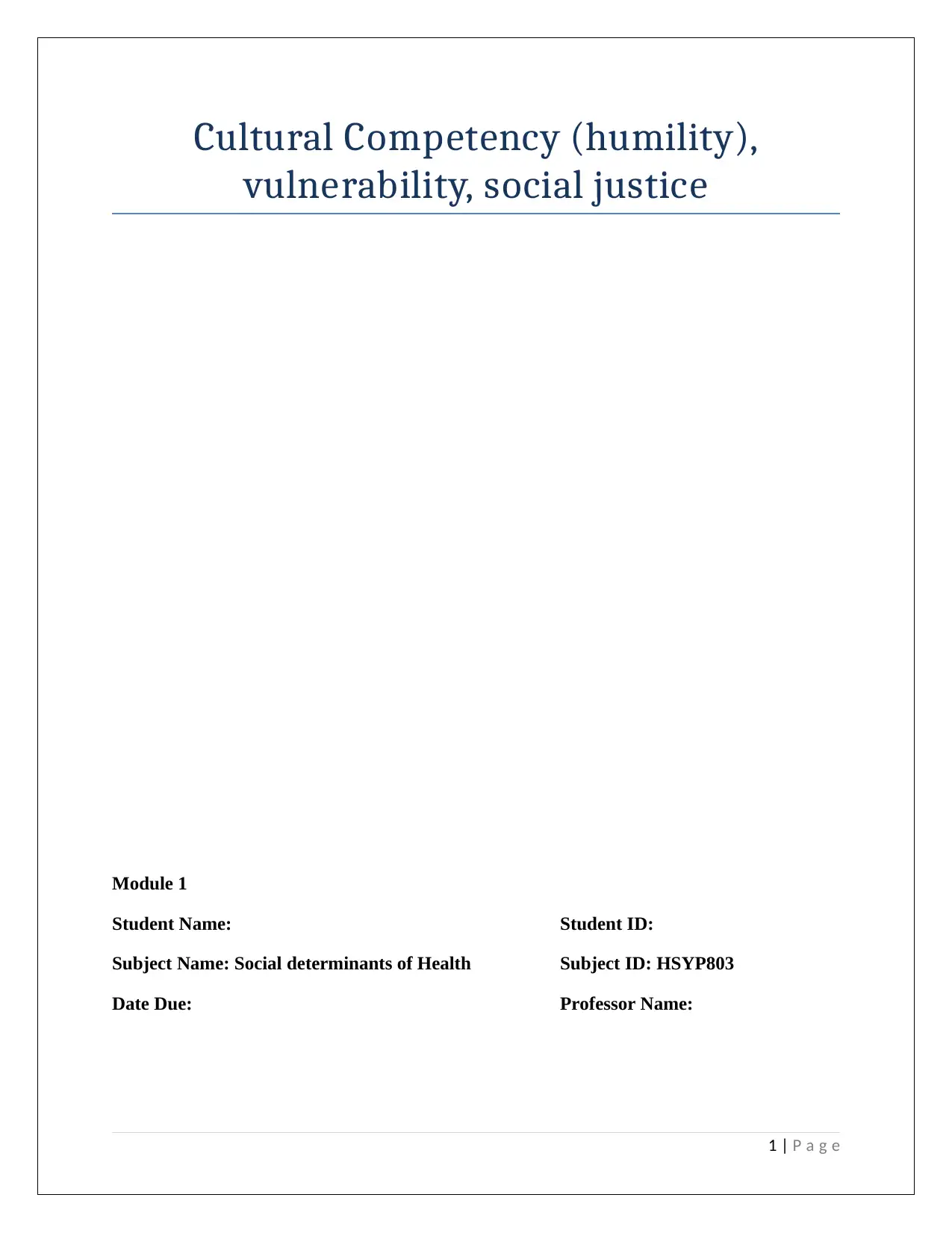
Cultural Competency (humility),
vulnerability, social justice
Module 1
Student Name: Student ID:
Subject Name: Social determinants of Health Subject ID: HSYP803
Date Due: Professor Name:
1 | P a g e
vulnerability, social justice
Module 1
Student Name: Student ID:
Subject Name: Social determinants of Health Subject ID: HSYP803
Date Due: Professor Name:
1 | P a g e
Paraphrase This Document
Need a fresh take? Get an instant paraphrase of this document with our AI Paraphraser
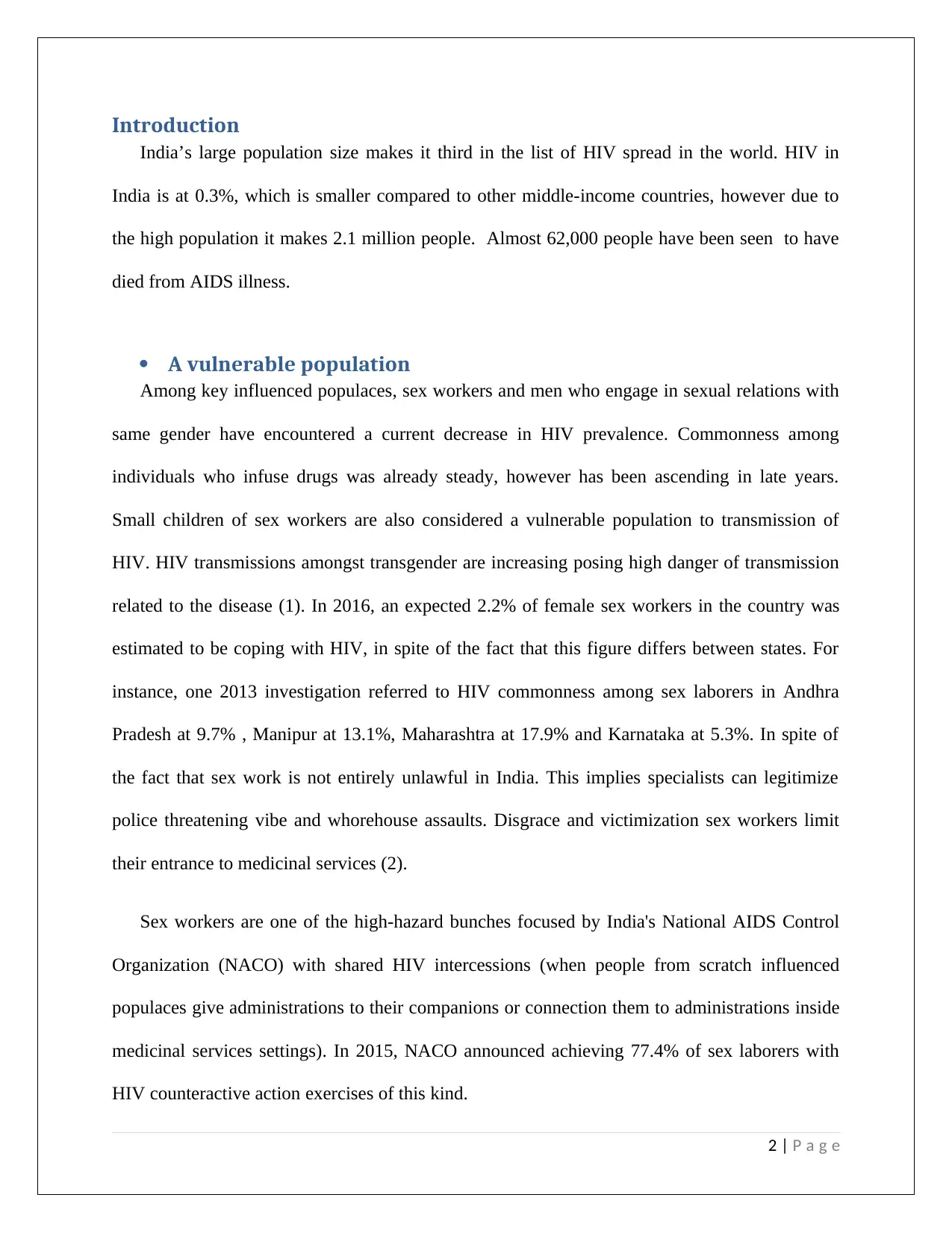
Introduction
India’s large population size makes it third in the list of HIV spread in the world. HIV in
India is at 0.3%, which is smaller compared to other middle-income countries, however due to
the high population it makes 2.1 million people. Almost 62,000 people have been seen to have
died from AIDS illness.
A vulnerable population
Among key influenced populaces, sex workers and men who engage in sexual relations with
same gender have encountered a current decrease in HIV prevalence. Commonness among
individuals who infuse drugs was already steady, however has been ascending in late years.
Small children of sex workers are also considered a vulnerable population to transmission of
HIV. HIV transmissions amongst transgender are increasing posing high danger of transmission
related to the disease (1). In 2016, an expected 2.2% of female sex workers in the country was
estimated to be coping with HIV, in spite of the fact that this figure differs between states. For
instance, one 2013 investigation referred to HIV commonness among sex laborers in Andhra
Pradesh at 9.7% , Manipur at 13.1%, Maharashtra at 17.9% and Karnataka at 5.3%. In spite of
the fact that sex work is not entirely unlawful in India. This implies specialists can legitimize
police threatening vibe and whorehouse assaults. Disgrace and victimization sex workers limit
their entrance to medicinal services (2).
Sex workers are one of the high-hazard bunches focused by India's National AIDS Control
Organization (NACO) with shared HIV intercessions (when people from scratch influenced
populaces give administrations to their companions or connection them to administrations inside
medicinal services settings). In 2015, NACO announced achieving 77.4% of sex laborers with
HIV counteractive action exercises of this kind.
2 | P a g e
India’s large population size makes it third in the list of HIV spread in the world. HIV in
India is at 0.3%, which is smaller compared to other middle-income countries, however due to
the high population it makes 2.1 million people. Almost 62,000 people have been seen to have
died from AIDS illness.
A vulnerable population
Among key influenced populaces, sex workers and men who engage in sexual relations with
same gender have encountered a current decrease in HIV prevalence. Commonness among
individuals who infuse drugs was already steady, however has been ascending in late years.
Small children of sex workers are also considered a vulnerable population to transmission of
HIV. HIV transmissions amongst transgender are increasing posing high danger of transmission
related to the disease (1). In 2016, an expected 2.2% of female sex workers in the country was
estimated to be coping with HIV, in spite of the fact that this figure differs between states. For
instance, one 2013 investigation referred to HIV commonness among sex laborers in Andhra
Pradesh at 9.7% , Manipur at 13.1%, Maharashtra at 17.9% and Karnataka at 5.3%. In spite of
the fact that sex work is not entirely unlawful in India. This implies specialists can legitimize
police threatening vibe and whorehouse assaults. Disgrace and victimization sex workers limit
their entrance to medicinal services (2).
Sex workers are one of the high-hazard bunches focused by India's National AIDS Control
Organization (NACO) with shared HIV intercessions (when people from scratch influenced
populaces give administrations to their companions or connection them to administrations inside
medicinal services settings). In 2015, NACO announced achieving 77.4% of sex laborers with
HIV counteractive action exercises of this kind.
2 | P a g e
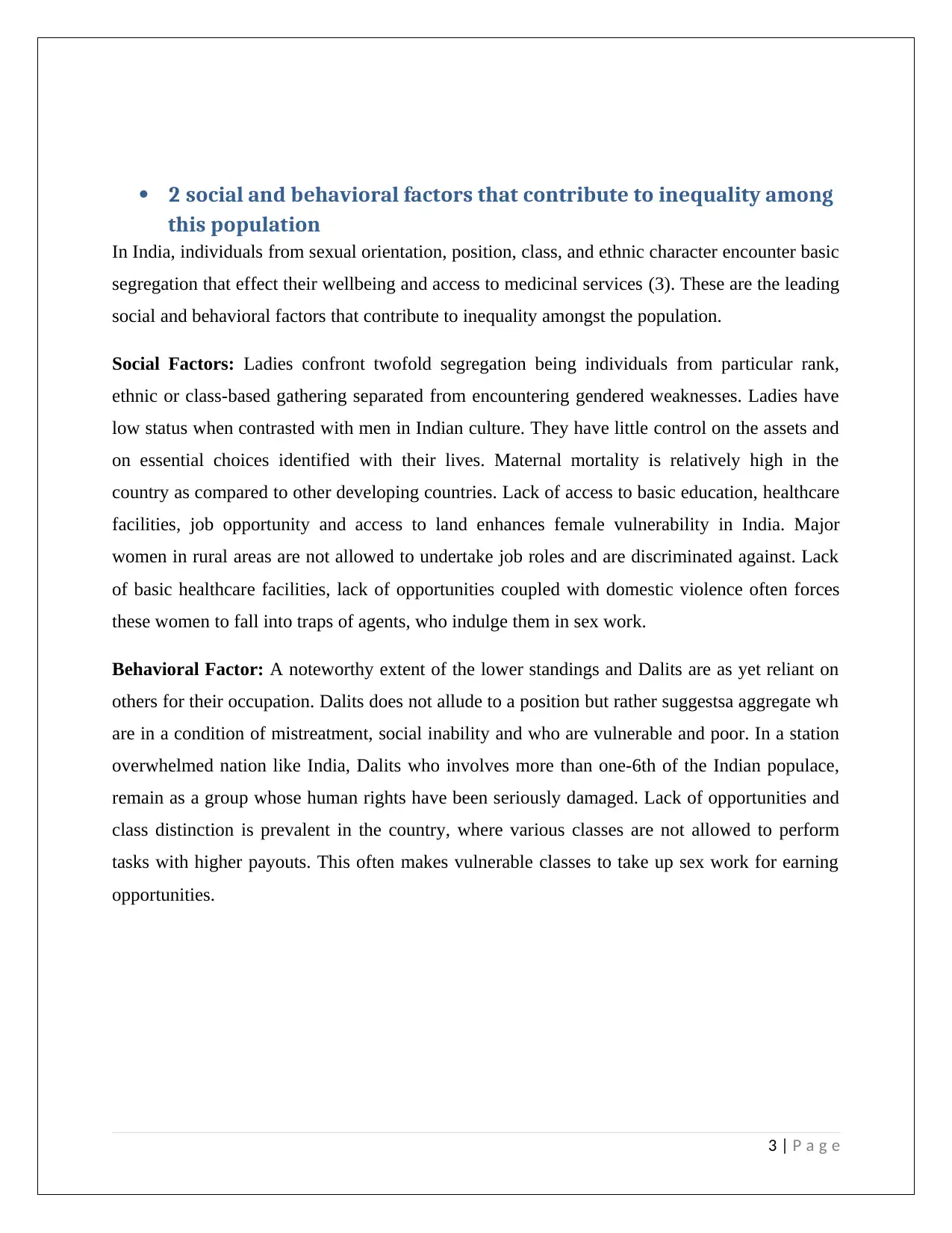
2 social and behavioral factors that contribute to inequality among
this population
In India, individuals from sexual orientation, position, class, and ethnic character encounter basic
segregation that effect their wellbeing and access to medicinal services (3). These are the leading
social and behavioral factors that contribute to inequality amongst the population.
Social Factors: Ladies confront twofold segregation being individuals from particular rank,
ethnic or class-based gathering separated from encountering gendered weaknesses. Ladies have
low status when contrasted with men in Indian culture. They have little control on the assets and
on essential choices identified with their lives. Maternal mortality is relatively high in the
country as compared to other developing countries. Lack of access to basic education, healthcare
facilities, job opportunity and access to land enhances female vulnerability in India. Major
women in rural areas are not allowed to undertake job roles and are discriminated against. Lack
of basic healthcare facilities, lack of opportunities coupled with domestic violence often forces
these women to fall into traps of agents, who indulge them in sex work.
Behavioral Factor: A noteworthy extent of the lower standings and Dalits are as yet reliant on
others for their occupation. Dalits does not allude to a position but rather suggestsa aggregate wh
are in a condition of mistreatment, social inability and who are vulnerable and poor. In a station
overwhelmed nation like India, Dalits who involves more than one-6th of the Indian populace,
remain as a group whose human rights have been seriously damaged. Lack of opportunities and
class distinction is prevalent in the country, where various classes are not allowed to perform
tasks with higher payouts. This often makes vulnerable classes to take up sex work for earning
opportunities.
3 | P a g e
this population
In India, individuals from sexual orientation, position, class, and ethnic character encounter basic
segregation that effect their wellbeing and access to medicinal services (3). These are the leading
social and behavioral factors that contribute to inequality amongst the population.
Social Factors: Ladies confront twofold segregation being individuals from particular rank,
ethnic or class-based gathering separated from encountering gendered weaknesses. Ladies have
low status when contrasted with men in Indian culture. They have little control on the assets and
on essential choices identified with their lives. Maternal mortality is relatively high in the
country as compared to other developing countries. Lack of access to basic education, healthcare
facilities, job opportunity and access to land enhances female vulnerability in India. Major
women in rural areas are not allowed to undertake job roles and are discriminated against. Lack
of basic healthcare facilities, lack of opportunities coupled with domestic violence often forces
these women to fall into traps of agents, who indulge them in sex work.
Behavioral Factor: A noteworthy extent of the lower standings and Dalits are as yet reliant on
others for their occupation. Dalits does not allude to a position but rather suggestsa aggregate wh
are in a condition of mistreatment, social inability and who are vulnerable and poor. In a station
overwhelmed nation like India, Dalits who involves more than one-6th of the Indian populace,
remain as a group whose human rights have been seriously damaged. Lack of opportunities and
class distinction is prevalent in the country, where various classes are not allowed to perform
tasks with higher payouts. This often makes vulnerable classes to take up sex work for earning
opportunities.
3 | P a g e
⊘ This is a preview!⊘
Do you want full access?
Subscribe today to unlock all pages.

Trusted by 1+ million students worldwide
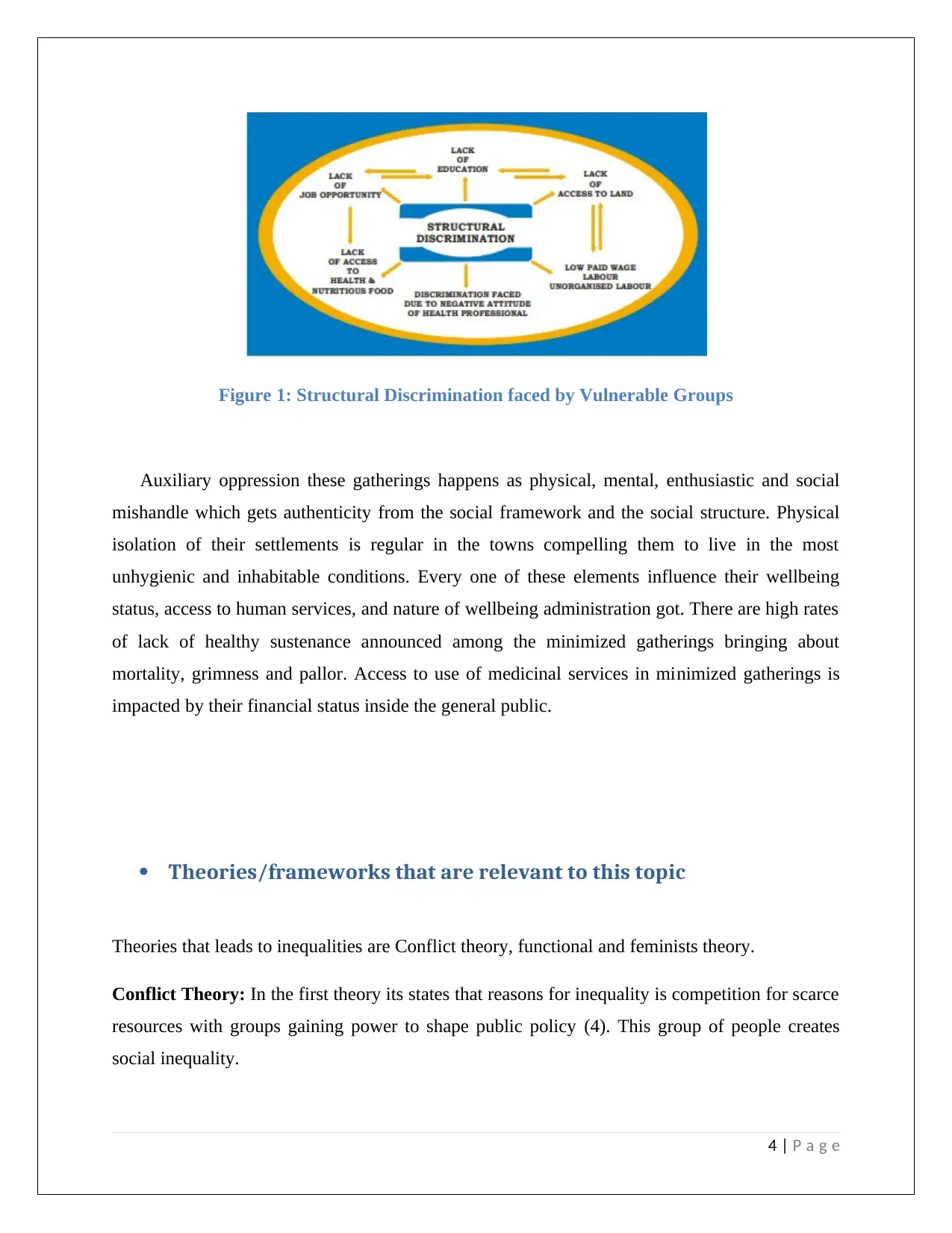
Figure 1: Structural Discrimination faced by Vulnerable Groups
Auxiliary oppression these gatherings happens as physical, mental, enthusiastic and social
mishandle which gets authenticity from the social framework and the social structure. Physical
isolation of their settlements is regular in the towns compelling them to live in the most
unhygienic and inhabitable conditions. Every one of these elements influence their wellbeing
status, access to human services, and nature of wellbeing administration got. There are high rates
of lack of healthy sustenance announced among the minimized gatherings bringing about
mortality, grimness and pallor. Access to use of medicinal services in minimized gatherings is
impacted by their financial status inside the general public.
Theories/frameworks that are relevant to this topic
Theories that leads to inequalities are Conflict theory, functional and feminists theory.
Conflict Theory: In the first theory its states that reasons for inequality is competition for scarce
resources with groups gaining power to shape public policy (4). This group of people creates
social inequality.
4 | P a g e
Auxiliary oppression these gatherings happens as physical, mental, enthusiastic and social
mishandle which gets authenticity from the social framework and the social structure. Physical
isolation of their settlements is regular in the towns compelling them to live in the most
unhygienic and inhabitable conditions. Every one of these elements influence their wellbeing
status, access to human services, and nature of wellbeing administration got. There are high rates
of lack of healthy sustenance announced among the minimized gatherings bringing about
mortality, grimness and pallor. Access to use of medicinal services in minimized gatherings is
impacted by their financial status inside the general public.
Theories/frameworks that are relevant to this topic
Theories that leads to inequalities are Conflict theory, functional and feminists theory.
Conflict Theory: In the first theory its states that reasons for inequality is competition for scarce
resources with groups gaining power to shape public policy (4). This group of people creates
social inequality.
4 | P a g e
Paraphrase This Document
Need a fresh take? Get an instant paraphrase of this document with our AI Paraphraser
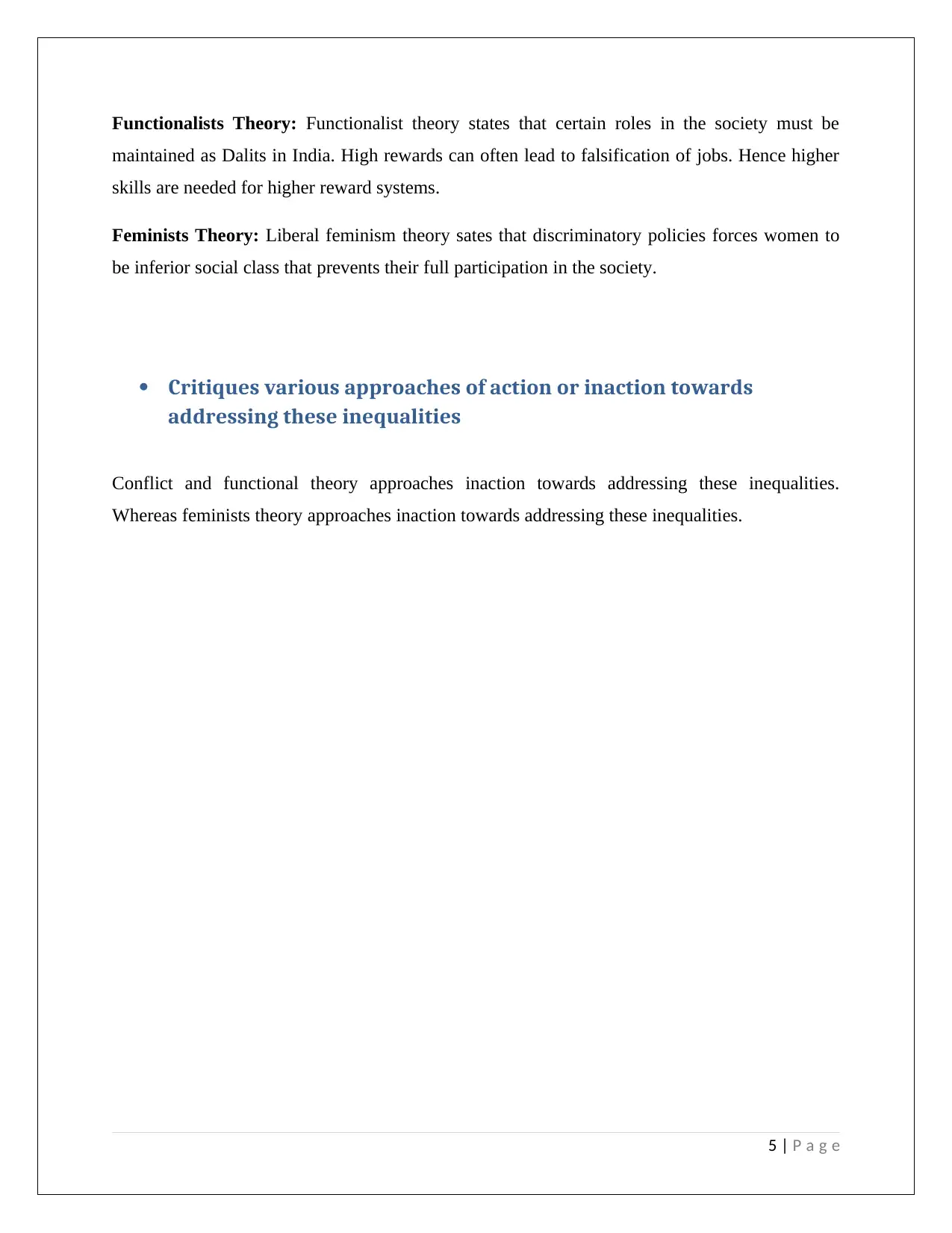
Functionalists Theory: Functionalist theory states that certain roles in the society must be
maintained as Dalits in India. High rewards can often lead to falsification of jobs. Hence higher
skills are needed for higher reward systems.
Feminists Theory: Liberal feminism theory sates that discriminatory policies forces women to
be inferior social class that prevents their full participation in the society.
Critiques various approaches of action or inaction towards
addressing these inequalities
Conflict and functional theory approaches inaction towards addressing these inequalities.
Whereas feminists theory approaches inaction towards addressing these inequalities.
5 | P a g e
maintained as Dalits in India. High rewards can often lead to falsification of jobs. Hence higher
skills are needed for higher reward systems.
Feminists Theory: Liberal feminism theory sates that discriminatory policies forces women to
be inferior social class that prevents their full participation in the society.
Critiques various approaches of action or inaction towards
addressing these inequalities
Conflict and functional theory approaches inaction towards addressing these inequalities.
Whereas feminists theory approaches inaction towards addressing these inequalities.
5 | P a g e
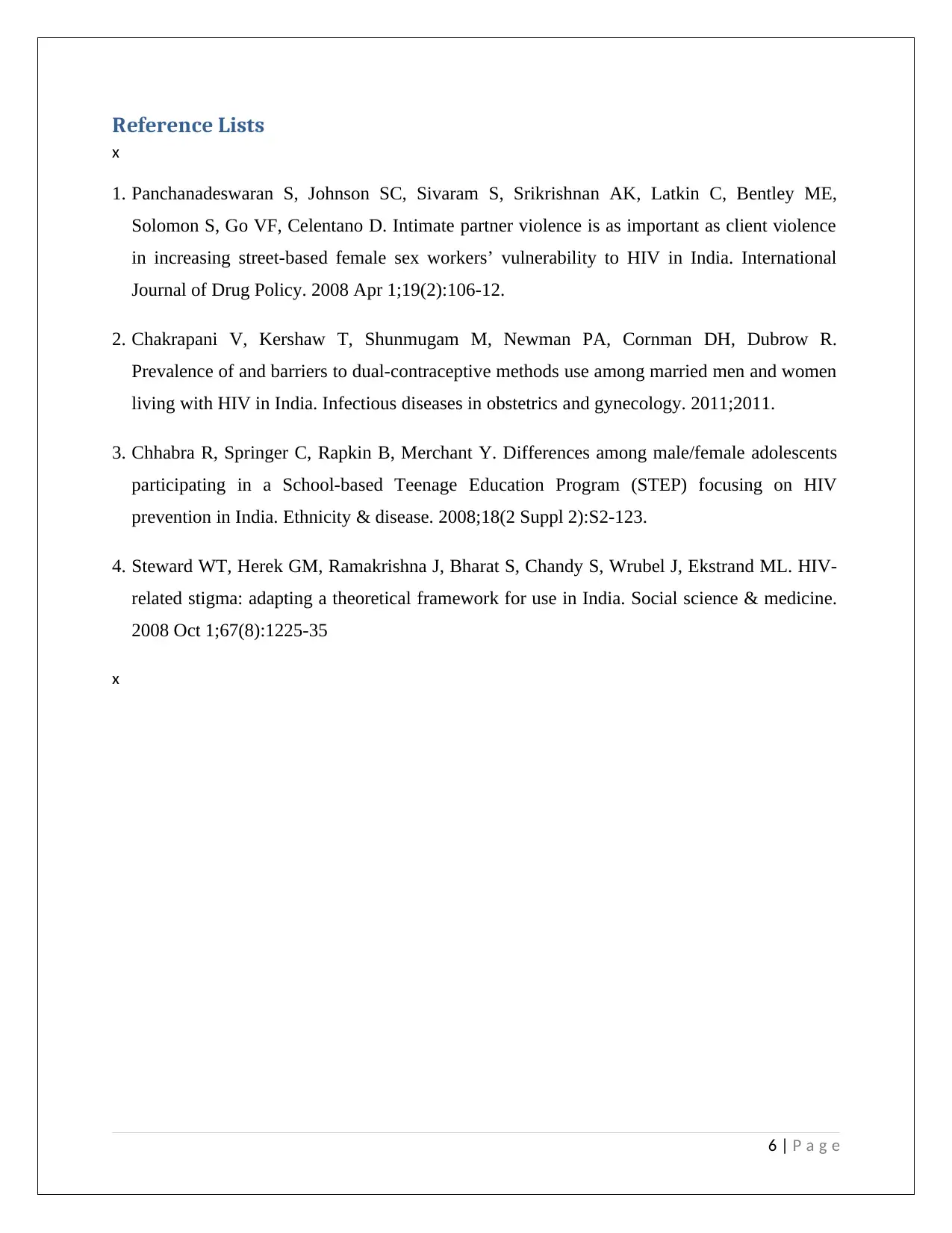
Reference Lists
x
1. Panchanadeswaran S, Johnson SC, Sivaram S, Srikrishnan AK, Latkin C, Bentley ME,
Solomon S, Go VF, Celentano D. Intimate partner violence is as important as client violence
in increasing street-based female sex workers’ vulnerability to HIV in India. International
Journal of Drug Policy. 2008 Apr 1;19(2):106-12.
2. Chakrapani V, Kershaw T, Shunmugam M, Newman PA, Cornman DH, Dubrow R.
Prevalence of and barriers to dual-contraceptive methods use among married men and women
living with HIV in India. Infectious diseases in obstetrics and gynecology. 2011;2011.
3. Chhabra R, Springer C, Rapkin B, Merchant Y. Differences among male/female adolescents
participating in a School-based Teenage Education Program (STEP) focusing on HIV
prevention in India. Ethnicity & disease. 2008;18(2 Suppl 2):S2-123.
4. Steward WT, Herek GM, Ramakrishna J, Bharat S, Chandy S, Wrubel J, Ekstrand ML. HIV-
related stigma: adapting a theoretical framework for use in India. Social science & medicine.
2008 Oct 1;67(8):1225-35
x
6 | P a g e
x
1. Panchanadeswaran S, Johnson SC, Sivaram S, Srikrishnan AK, Latkin C, Bentley ME,
Solomon S, Go VF, Celentano D. Intimate partner violence is as important as client violence
in increasing street-based female sex workers’ vulnerability to HIV in India. International
Journal of Drug Policy. 2008 Apr 1;19(2):106-12.
2. Chakrapani V, Kershaw T, Shunmugam M, Newman PA, Cornman DH, Dubrow R.
Prevalence of and barriers to dual-contraceptive methods use among married men and women
living with HIV in India. Infectious diseases in obstetrics and gynecology. 2011;2011.
3. Chhabra R, Springer C, Rapkin B, Merchant Y. Differences among male/female adolescents
participating in a School-based Teenage Education Program (STEP) focusing on HIV
prevention in India. Ethnicity & disease. 2008;18(2 Suppl 2):S2-123.
4. Steward WT, Herek GM, Ramakrishna J, Bharat S, Chandy S, Wrubel J, Ekstrand ML. HIV-
related stigma: adapting a theoretical framework for use in India. Social science & medicine.
2008 Oct 1;67(8):1225-35
x
6 | P a g e
⊘ This is a preview!⊘
Do you want full access?
Subscribe today to unlock all pages.

Trusted by 1+ million students worldwide
1 out of 6
Your All-in-One AI-Powered Toolkit for Academic Success.
+13062052269
info@desklib.com
Available 24*7 on WhatsApp / Email
![[object Object]](/_next/static/media/star-bottom.7253800d.svg)
Unlock your academic potential
Copyright © 2020–2025 A2Z Services. All Rights Reserved. Developed and managed by ZUCOL.
